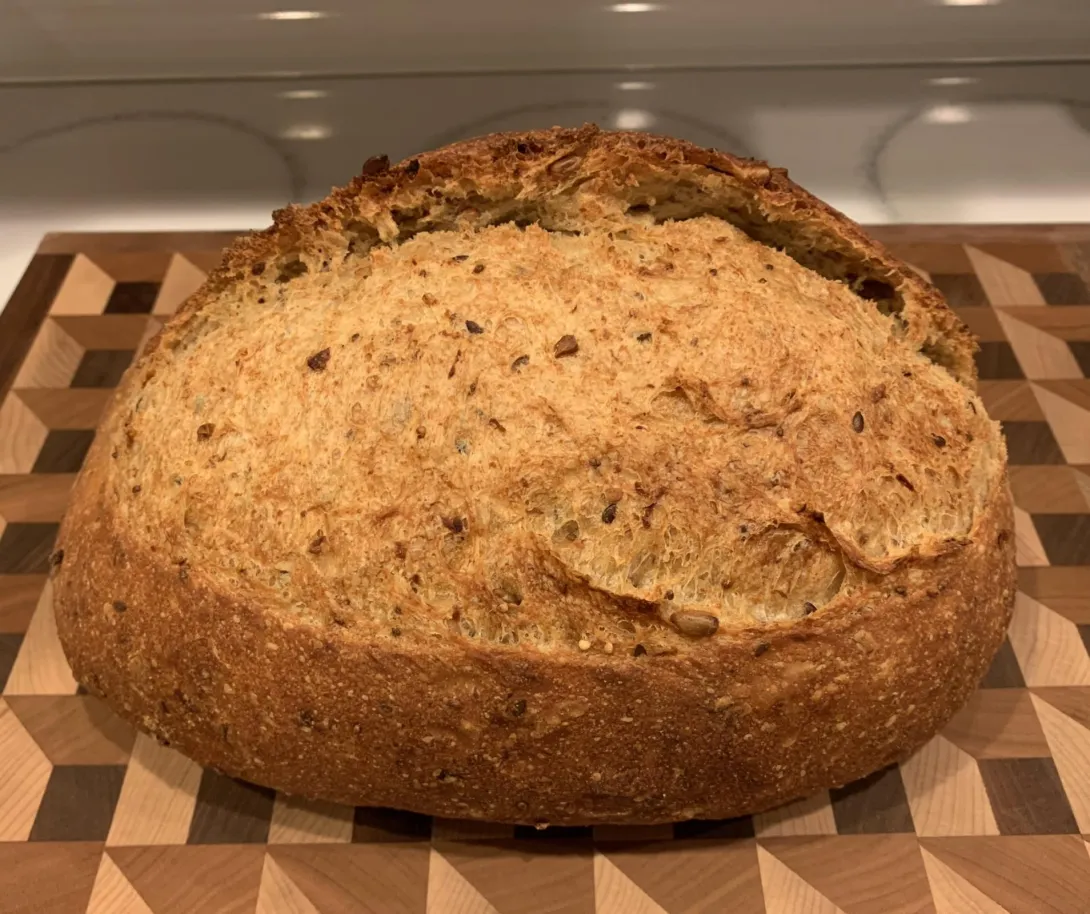
The other request for the weekend was a porridge bread. I've made this one quite a few times now, and it's becoming a go-to bread when I get a request for a loaf. To-date, I've always made the porridge as a soaker about 1-2 hours before final mix. This time I made it as a mash following Benny's recent post. My usual mash method followed Peter Rhinehart's (heat water to 165 deg F, add grains, hold temp at 150 deg F for 1-3 hours). For this bake, I cooked the porridge in the microwave until it just started to boil (about 40 seconds) and then set in on the counter top to cool. Porridge temp after removing from the microwave was just over 200 deg F. Let cool to 150 deg F and then add 0.5g of malted wheat berries (crushed).
Biga
120g Bread Flour
72g Water
0.4g Active Dry Yeast
Mix until flour wetted and then ferment at 70 deg F for 12-14 hours
Porridge (Made as a Mash)
24g Rolled Oats
12g Corn Meal (or polenta)
6g Hulled Millet
5g Flaxseed
5g Chia Seed
5g Roasted Sunflower Seed
4g Almonds (finely chopped)
0.5g Malted Wheat Berries (crushed) (or diastatic malt powder)
107g Water
1) Set Crockpot to warm with Inkbird temp controller set to 148 deg F.
2) Add 1.5-2 inches of 150 deg F water to the Crockpot, put lid on, and cover with towels to insulate it.
3) Combine ingredients except malted wheat berries in a microwavable bowl (preferably clear) and cover to avoid losing too much water.
4) Microwave until the mixture just starts to boil
5) Allow mixture to cool at room temp in a covered bowl until it reaches 150 deg F.
6) Stir in malted wheat berries
7) Keeping bowl covered, place it in the Crockpot for 3-6 hours (I went for 4 hours)
8) Remove from Crockpot and let cool to <110 deg F before using in Final Mix.
Final Dough
200g All-Purpose Flour
20g Bread Flour
60g Whole Wheat Flour
152g Water
8.8g Salt
2g Active Dry Yeast
1) Combine all Final Dough ingredients except salt. Mix until flours are all wetted. This will be quite a stiff dough. Let rest on bench in a covered bowl for 15 minutes.
2) Break up biga into chunks and spread across autolyzed dough. Starting working the biga and salt into the autolyzed dough along with small amounts of the porridge. Slowly fold in the porridge until the dough is uniform. The moisture from the porridge will loosen the dough. Let rest for 10 minutes.
3) Develop medium gluten by doing 3 sets of bowl kneading with 10 minute rests.
4) Place in oiled bowl and bulk ferment at 74 deg F. Do a fold at 30 minutes.
5) Let dough double in volume. Degas and preshape. Bench rest 15 minutes.
6) Final shape and final proof at 74 deg F.
7) Preheat oven at 465 deg F with Fibrament baking stone in place for 45-60 minutes. Pre-steam oven with 1/4 cup of water 5 minutes before loading dough.
8) Bake at 465 deg F (1 minute); 400 deg F (19 minutes); vent oven; 425 deg (10-15 minutes); remove from oven when you get a hollow thump.
This one progressed a little faster through bulk and final proof than previous loaves. Best guess... The mash process converted more starches to sugars than my regular soaker process. Crumb is moist and tender!
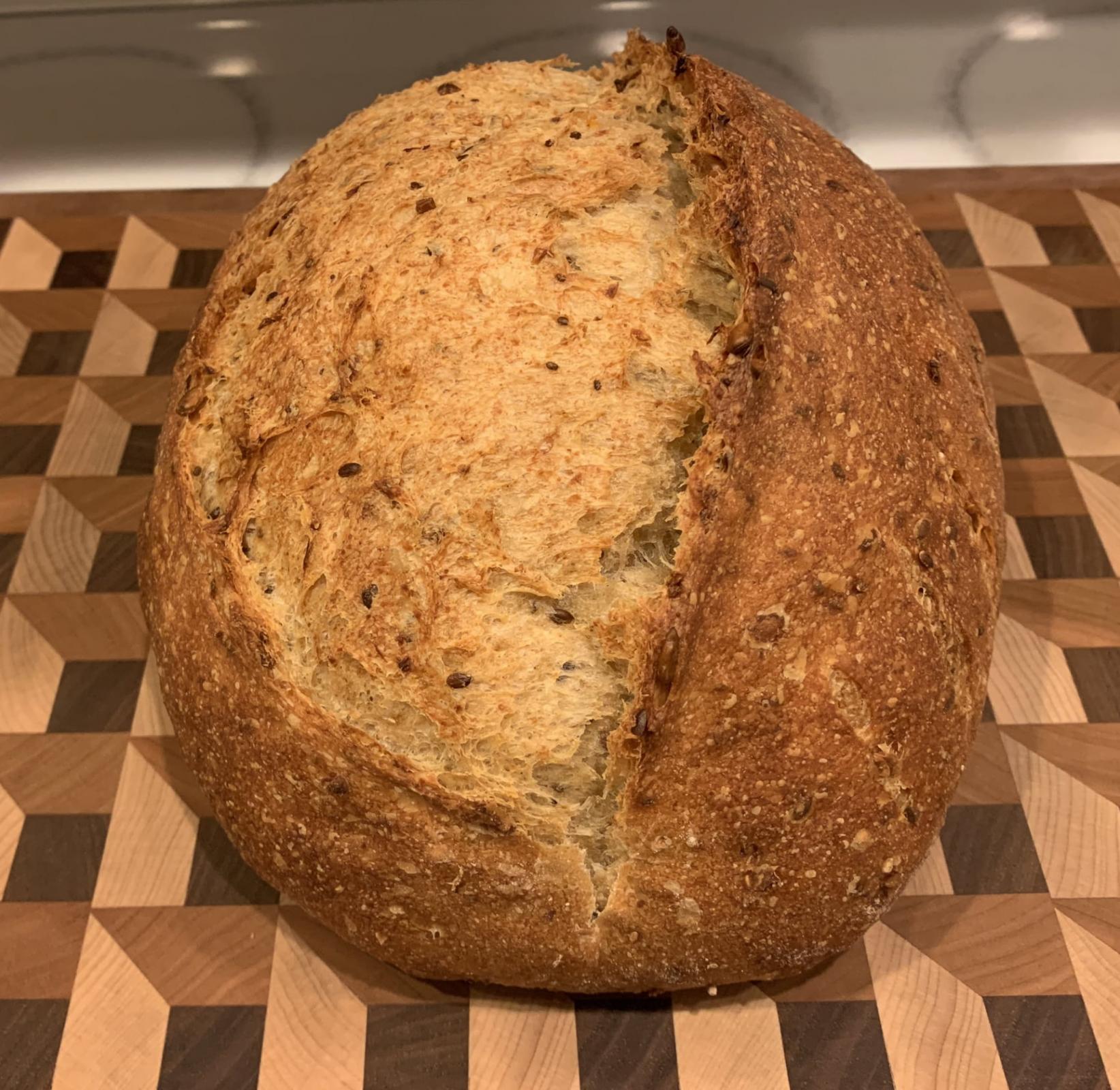
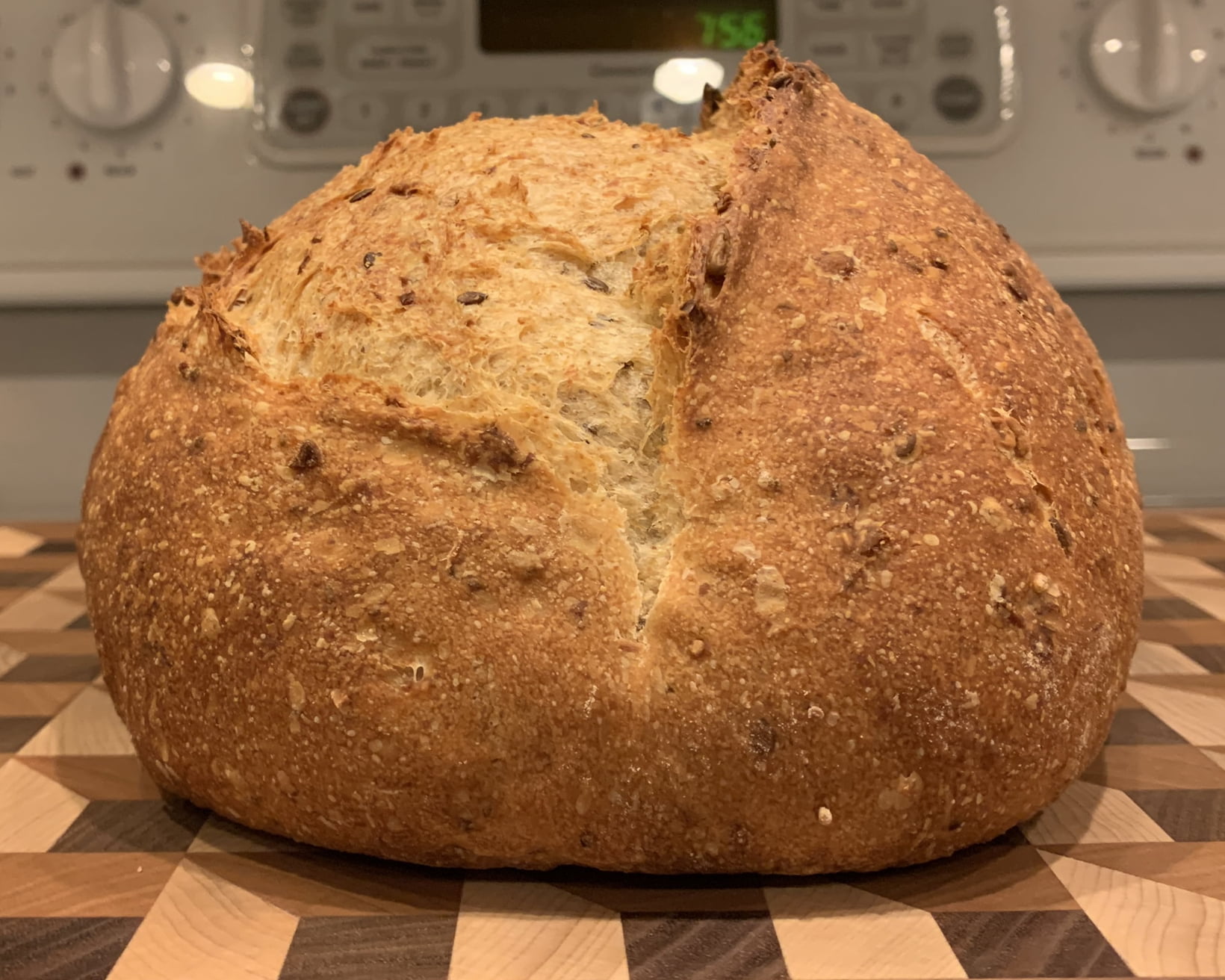
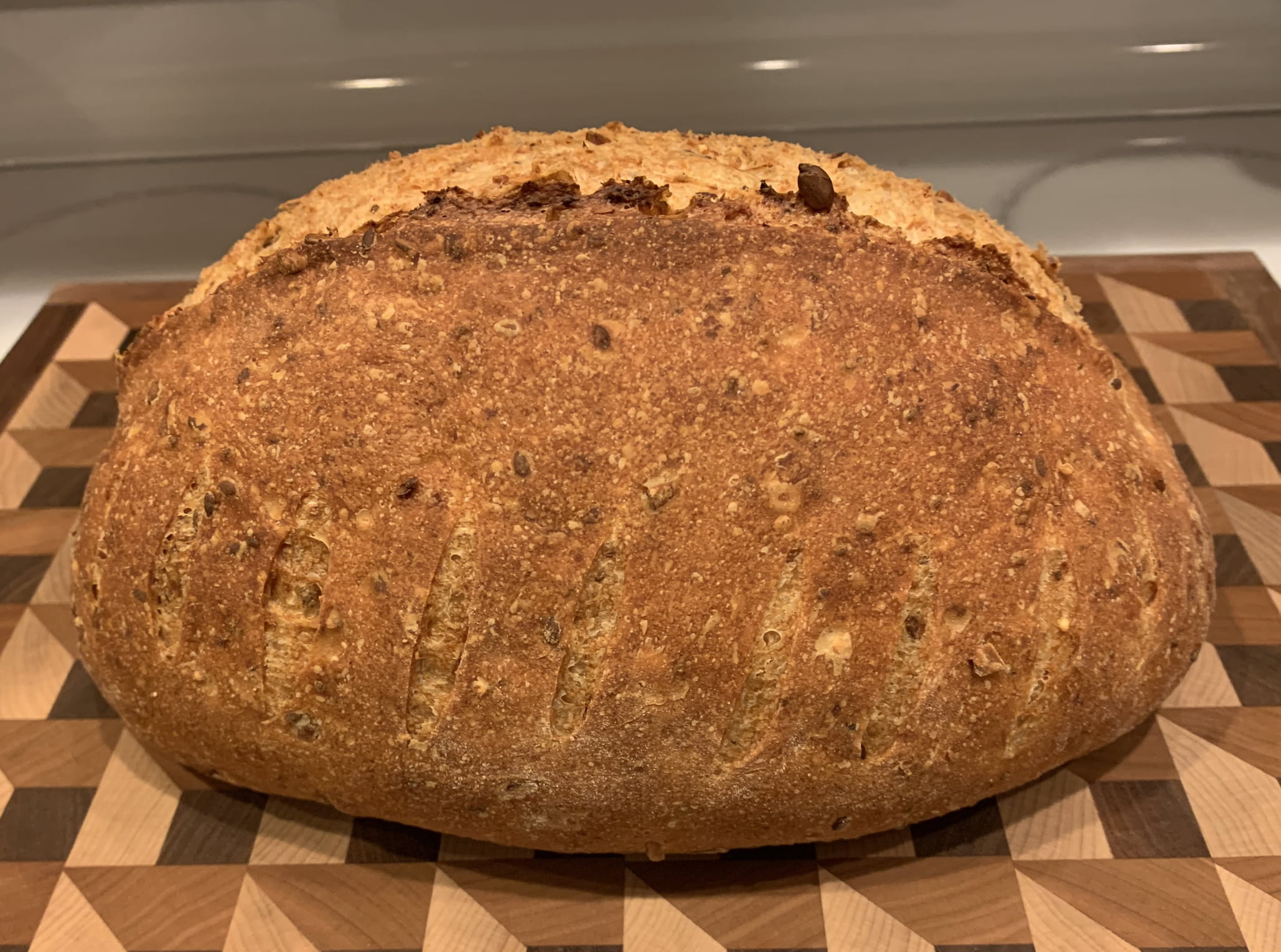
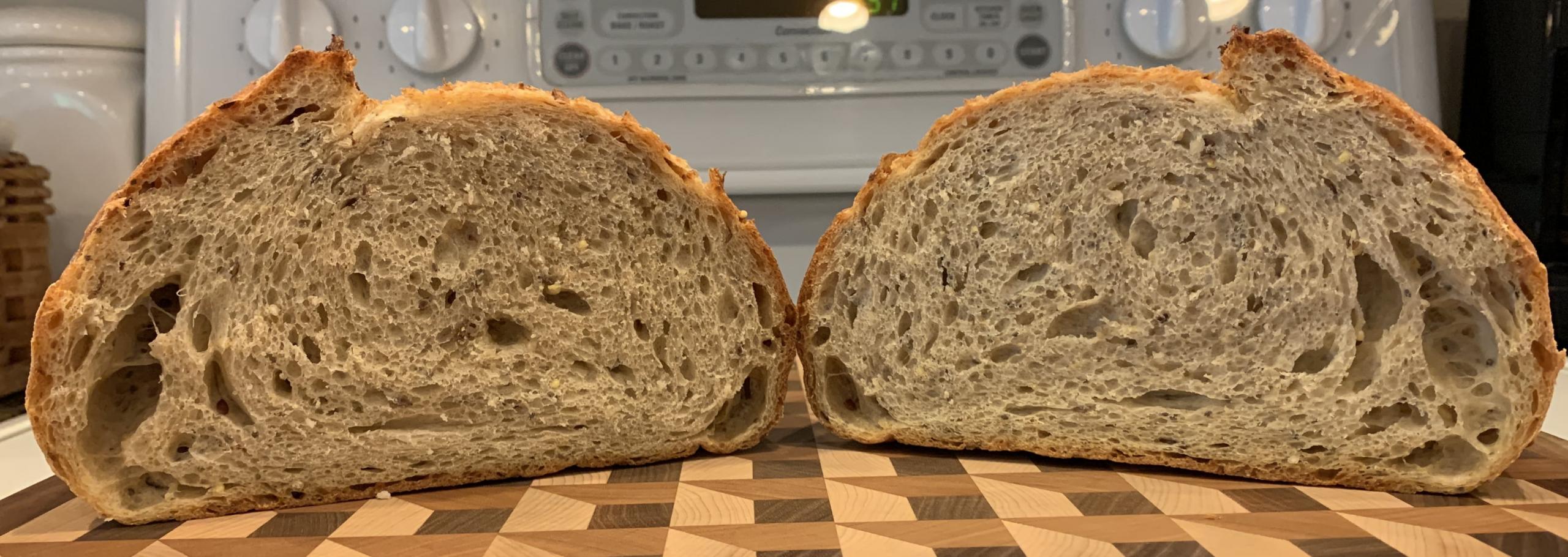
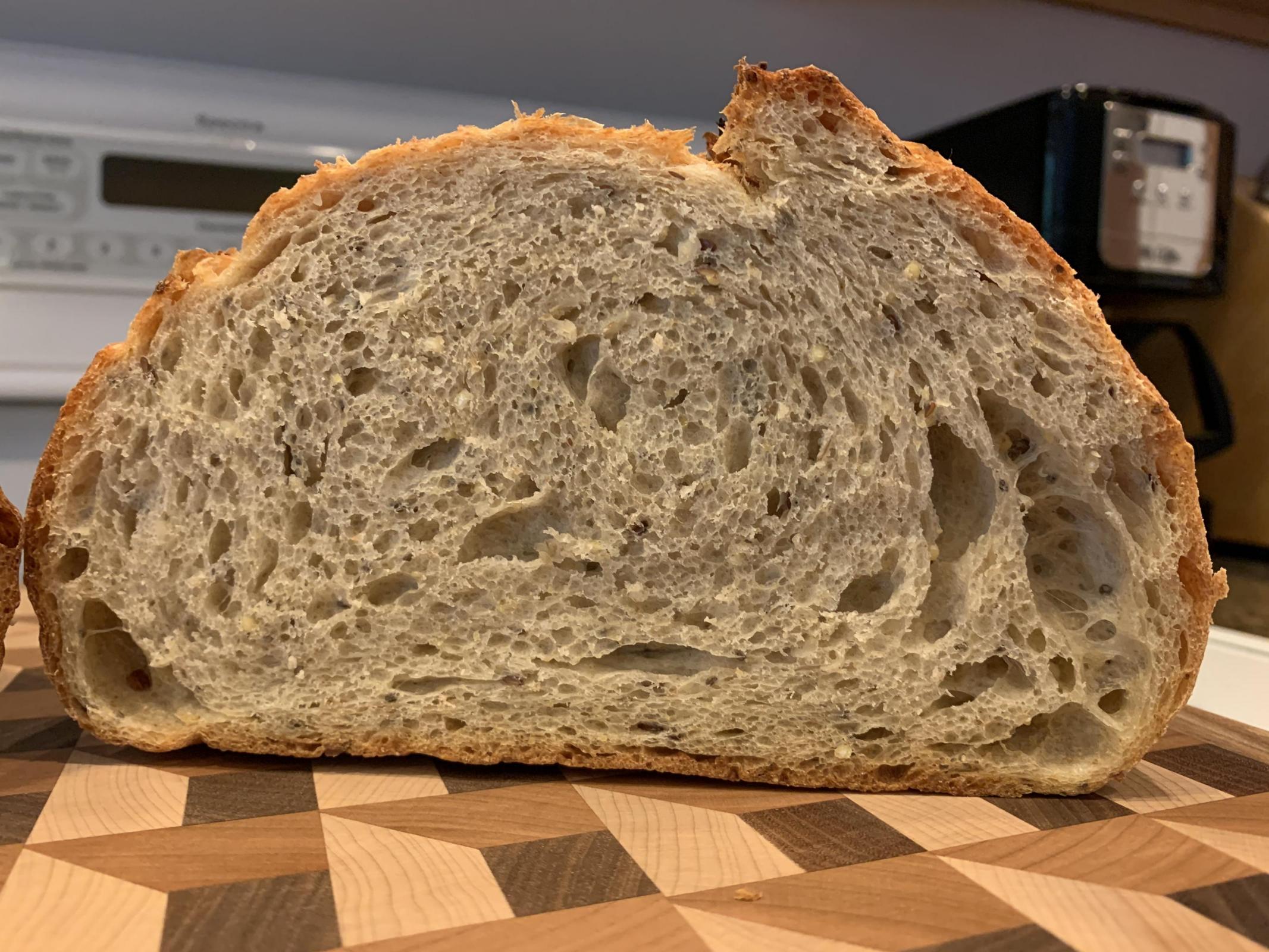
- HeiHei29er's Blog
- Log in or register to post comments
A great looking loaf, Troy. The crumb looks nice and supple. I like the idea of the porridge mash - did it taste sweet after mashing?
Lance
Thank you Lance. I didn't taste the mash (should have and will next time), but it had a really nice aroma. I think the early indication for me that more sugar was present was the speed of fermentation. I've made this bread 4-5 times, and all previous bakes used a soaker where I put boiling water on the grains 1-2 hours before final mix. This bake definitely progressed faster than the previous.
That’s a great looking loaf Troy, nice job with the Saccharified porridge. My Saccharified porridge loaf fermented more quickly than the regular porridge version as well. It sounds like you got a nice crumb, were you pleased with the flavour.
Benny
Thanks Benny. I haven't tried this one yet (still enjoying the Rye Spelt :-) ), but my mom and dad both liked it a lot.
Any thoughts on the large air bubble. If there's one thing I'd like to improve in my bakes right now is the large pockets I'm getting. I can't figure out where they're coming from. I'm assuming it's either a shaping error, a lack of degassing, or maybe too much degassing which is causing small bubbles to combine but then not getting rid of all the large bubbles.
I would have said trapped air during folds or shaping would have been the cause of that bubble. You mention degassing, what do you do to degas? Do you pop bubbles you find during folds?
If it’s a single loaf, I usually do a bowl S&F to pre-shape and then form a round. I pop any bubbles that come to the surface during that process.
For multiple loaves, I usually do a S&F to form a round on the counter top and then tighten it up as a round. Pop any bubbles that come to the surface.
Do you pat your dough as you shape? I think that has an evening effect on the gas in the dough and reduces larger bubbles.
If I pat it, I usually do it as I’m spreading out the round after resting.
Aww, look at those chubby li'l guys! They look might tasty. I get those larger air bubbles sometimes too and have always thought them shaping errors. I think shaping is one of my biggest weaknesses as a baker, but I'll be following to see if others disagree. Always appreciate an opportunity to learn something... Meantime, they don't affect the flavor, so enjoy!
–AG
Thanks AG! I wholeheartedly agree with you on the flavor. The engineer in me just wants to know where that bubble comes from. 😉
This looks glorious and exactly the kind of bread I love...got lots going on! I've yet to try a dry(ish) biga recipe but this post is inspiring! I've been following the corn mash adventures being posted the last few weeks with a lot of interest as I love corn meal as a bread ingredient. I've got a thermos type apparatus that I use to make yogurt in and am thinking about giving the mash a try...so curious about the possible differences in flavor from just adding cornmeal into the autolyse pool.
Great post and lovely bread!
Thank you Leigh. I use a biga or a pate fermente on almost all of my ADY breads. The only challenge I’ve had is getting the clumps out when I went really dry (45% hydration) and with a really high preferment (90%). Only made that mistake once….
Agree with you on the use of corn meal or polenta. It adds a really nice flavor! Give the mash a try. It takes a bit of planning ahead, but the additional prep time it takes is minimal.